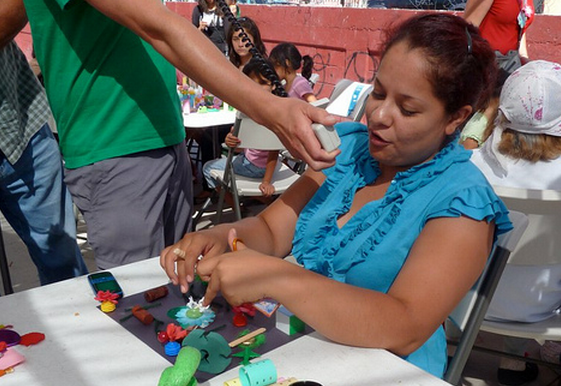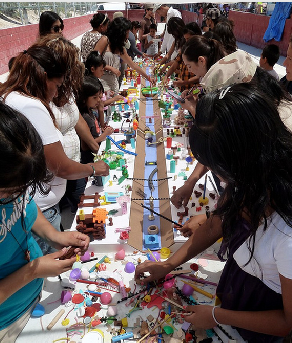
On August 5th and 6th I facilitated a high-energy, successful community visioning activity for Camino Verde, a colonia in Tijuana organized by Reacciona Tijuana. This project started as a collaboration between Giacomo Castagnola, architect/artist and myself as part of an urban planning art exhibition being organized in October for the Museum of Latin American Art.
I wanted Castagnola to experience the new method of community engagement for urban planning I developed. Castagnola, based in Tijuana has many colleagues working in the realm of art and social change. He identified Gabriela Posada del Real as a partner and she identified the project area. The Tijuana colonias are an ideal venue to implement this hands on method of community engagement.
Del Real identified Camino Verde as the project site. She is currently working there with Luis Garzón an artist painting houses and fences. She also has a strong relationships with the women of this community. Camio Verde is an informal neighborhood or colonia in Tijuana that developed along a dry creek similar to LA’s Arroyo Seco. This creek forms a valley. On both sides of the valley homes and small business have developed along the hillsides. The roads and houses developed organically embracing the topography shaping a unique landscape.
In the middle of the informal development is the dry river bed which creates a strong sense of place in the community since it proves both physical and visual open space. The major road with buses run along it and commercial business have developed along it. On the weekend a weekend swapmeet has developed on this road and river bed.
The creek has been channalized with concrete similar to the LA River. Garbage and graffettii fill the concrete channel, however many children play in it because it provides the only centrally located, flat open space in the hilly landscape.
Tijuana city officials want to cover the concrete river bed and create a much needed park and open space.
Our process was two fold. It was to engage the community in the urban planning process and hear their ideas about the place they live.
Our workshop took place outside on a small concrete soccer field adjacent to the river bed. The women of the community set up tables, chairs and a tarp for shade that was attached to fences on either side. Four tables were set up in a square with color consruction paper placed on it. The building materials were placed in the middle of the square to allow for easy access.
Our first workshop took place on Friday afternoon. It started at 3:00 and ended around 6:00 p.m. We had over forty participants ranging from six to seventy years. The first workshop’s goal was to have the community members develop and create their own ideal city or neighborhood. Participants were given the task to design their ideal place in twenty minutes based on their personal knowledge, experiences, and needs. This time allowed participants to self-reflect by investigating the environment. There were no maps, pictures, scale, and no wrong or right answers, only that everybody build a 3 dimensional model. Using a medley of recycled, vibrant materials, and colored construction paper, participants used their hands and minds to to build their ideal space.
The Camino Verde youth scrambled around the table to find their materials. The thousands of colorful, tactile objects were like candy and triggered the youth emotional connections to the environment. The adults followed. By using non-represent objects people were forced to be creative. Green yarn becomes grass, blue poker chips become the ocean, and hair rollers become apartments or office buildings.
By using their hands to build participant are allowed to investigate their relationship with the built environment. They can freely move objects to discover relations between activities and create small vignettes of urban life. Participants gain the greatest satisfaction from this process because they were able to translate memories, visions, and ideas from their mind into a physical form. Participants have an epiphany because they learn what creates their ideal space.
When they completed the design challenge they had one minute to present their individual solutions to the group. We went from table to table with a speaker to head each idea created. Participants created very complicated models. Unlike talking where you say a statement the models allow participants to develop comprehesive ideas. For the youth the excerise was about playing. They aproach their models as if they were playing a game so it was easy for them to engage and build while it was a bit more difficult for senior citizens.
After each one presented, each table was tasked to present create one city using all the best ideas from each individual. They also had to name each city.
Day Two Camino Verde Interactive Model
On Saturday morning from 11:00 to 2:00 we held a second interactive model building activity. Catagnola and myself created a conceptual model of the Camino Verde. The model was a thought provoking, diorama of the community. The model was designed for the viewer to ponder, explore, and participate in creating a vision for the community’s future.
We arrived an hour before the activity began to built a eighteen foot long by thirty inch model of the community. The Camino Verde interactive model was designed by Castagnola and myself as conceptual representation of this place that captured its landscape and urban form. The model was constructed from cardboard and foam core, and glue with the help of volunteers.
The dry river bed was in the center of the cardboard model. This helped the residents idenify their community. The goal for the model was the residents would be able to bring their ideas from the prevouse workshop and place it in Camino Verde.
The Camino Verde interactive model was placed adjacent to the dry river bed on the same spot we facilitated the workshops. Again the women of the community set up tables, tents, and a tarp for shade.
The model was seen by many people shopping at the street stalls. This was the perfect venue for participants to explore the community’s urban landscape
The installation also created an intimate scale that balanced out the cavernous open space of the valley. This set the stage for participants to discover what creates the place in they live. The installation enacted the river bed like any great public space where there was room for active and passive participation. People created their worlds while others watched the phenomena.
The hundreds of small, vibrant materials helped the residents visualize there community. Participants observed the miniature vibrant landscape for a few minutes and than they began to read the model as a map. They would begin to orientate themselves on the model/map with the help of the river. Once participants understood the diorama they began to interact with it and rearranged the building and landscape pieces on the model.
From this point on the viewer becomes the participant and projects themselves into the model. By the participants projecting their memories by touching and moving the small buildings on the model they began to investigate various urban forms that creates Camino Verde. They develop, and sculpture their own ideas about its physical nature.
The installation was a transformative experience for the inhabitants of Camino Verde. They received the diorama with great enthusiasm. People contemplated the model and milled around it. They smiled, laughed and spoke to strangers about urban planning issues. They stayed any where from twenty minutes to a few hours.
Every one brought their personal baggage to the diorama. Young men took risked and built tall, precarious towers or water parks. Women were the most enthusiastic because many of them never have this opportunity to build and create cities. Many women thought about home and what that means to them by examining forms, shapes and colors.
Participants walked away from the model with a sense of accomplishment, hope, and empowerment. As peopled played --they dabbled, moved a few things around, talked about how cool it would be if only.... and then they moved some more things, see something new take shape, begin to have real conversations about re-envisioning the cities ("Wouldn't it be great if...").... and finally, they and walk away realizing how empowering it is to "play" with these movable pieces, how truly dynamic and plastic (in the sense of changeable/adaptable) cities are, and how much potential this kind of exercise has for truly reinventing our cities.








